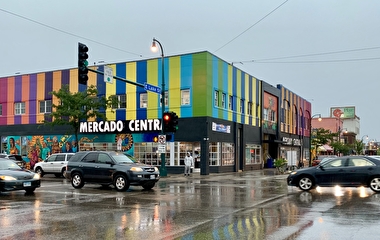
Solving real-world problems sometimes requires a very boots-on-the-ground approach. When Metro Transit began experiencing a bus driver shortage, researchers from the U of M decided to do some first-hand observations of bus dispatcher life in order to develop a tool that could make scheduling easier.
The TransitLight web app was designed as a way to enhance the scheduling process for “extra-board” operators—Metro Transit bus drivers whose job is to fill in the irregular gaps left in the schedule when other drivers get sick, go on vacation, or otherwise can’t make it. Scheduling them is a resource balancing act, because although they are cheaper by the hour than drivers working overtime, they’re less flexible—their schedules are determined weeks in advance and they’re required to work eight-hour-minimum shifts.
The app is the result of a multi-phase collaboration between the U of M and Metro Transit that began in 2017. Qie He, a former assistant professor in the Department of Industrial and Systems Engineering, led the app development. His main contact at Metro Transit, Eric Lind, says He’s method of sending graduate students to observe the bus-dispatching process yielded some unique results.
“Overall, it went really well,” says Lind, manager of research and analytics at Metro Transit. “Because we had [the students] around so often, they got to understand our business—what we’re doing, the problems we’re looking at [and] trying to work on."
The graduate students spent time learning how the bus schedule is typically divided among regular and extra-board operators. They also picked up some of the niche vocabulary of the bus dispatchers, incorporating it into their modeling and making communication between the two groups easier overall.
When it came time to develop the analytics tool, the researchers decided to use data pulled from data-monitoring and schedule-management software used by Metro Transit. This gave them information on uncovered work, overtime usage, and extra-board utilization, as well as the number of trips lost for lack of an operator, if any.
Using this data, the web app can display the known uncovered work for the next day, known available extra-board operators for the next day, and predictions (based on data from March 2017–March 2019) about the amount of work that will become open the next day.
“It takes a daily snapshot of how many operators are assigned, how many are missing, and then makes predictions about how many extra operators will be needed for the next day’s work,” Lind says. It has the potential to streamline the scheduling process and make it easier to find the right balance between overtime drivers and extra-board operators, he adds.
The TransitLight app is currently running—gathering fresh data and making new work availability predictions at 5:15 a.m. every day—but has yet to be incorporated into the scheduling process for the dispatchers.
“The next step for us, internally, is to put it in front of the daily decision makers at the different garages,” Lind says, “to kind of test it against their intuition and understand how it could be added to their workflow. We’re going to modify it a little bit. I don’t think it was exactly what we need, but it was a huge jump start.”
Writer: Sophia Koch


